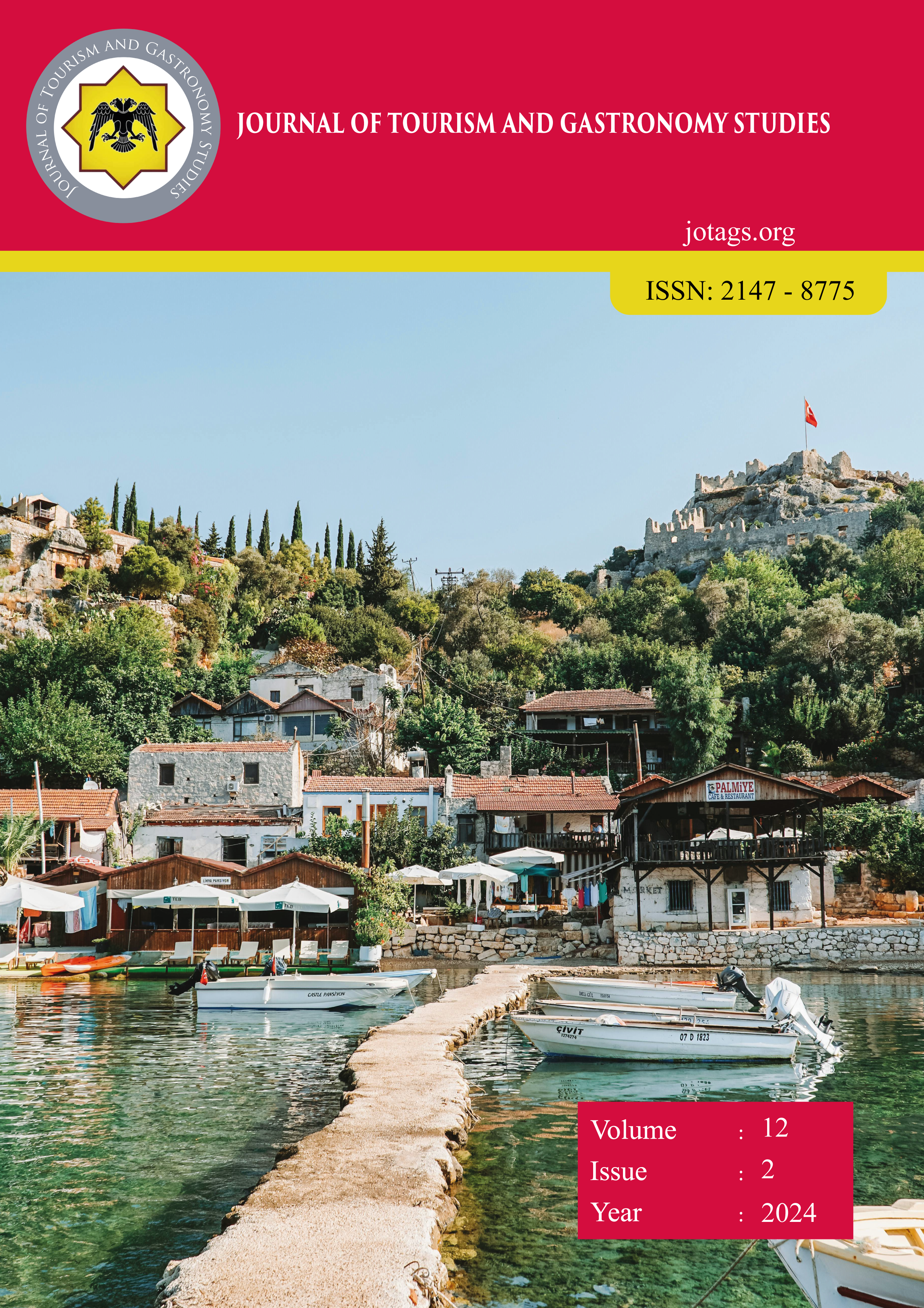Sinop’un Yenilebilir Otları ve Baharatları (Edible Herbs and Spices of Sinop)
DOI:
https://doi.org/10.21325/jotags.2024.1410Keywords:
Gastronomy, Edible herbs, Spices, SinopAbstract
Local flavours are among the important attractions for gastro-tourists. Sinop has a rich variety of edible herbs and spices due to its climate and geographical structure. This study aims to reveal the edible herbs and spices inventory of Sinop. The study focus to contribute to both the literature and the cultural capital of the city. In the study, 32 face-to-face interviews were conducted with residents in the central market of Sinop. As a result, 20 different herbs and spices in the Sinop market were identified. Moreover, the usage patterns and health benefits of these plants were revealed. Also, some plants are widely used in specially prepared dishes, salads and pickles. These findings provide potential for the utilisation of plants in nutrition and health. For sustainable development, local edible plants are important economic values that should be transferred to future generations. In conclusion, these plants are important for economic and cultural sustainability and it is recommended to promote their utilisation.
References
Cambridge Dictionaries Online. (2023). Erişim Tarihi: 09/10/2023 http://dictionary.cambridge.org/
Ceylan, F. & Şahingöz, S. A. (2019). Yenilebilir otlar tüketim alışkanlığı: Düziçi örneği. Journal of Tourism and Gastronomy Studies, 7(3), 2204-2225.
Corlett, R. T. (2016). Restoration, reintroduction, and rewilding in a changing world. Trends in Ecology & Evolution, 31, 453-462. doi:10.1016/j.tree.2016.02.017
Demir, E., Sürmen, B., Özer, H., & Kutbay, H. G. (2017). Salıpazarı ve çevresinde (Samsun/Türkiye) doğal olarak yetişen bitkilerin etnobotanik özellikleri. Karadeniz Fen Bilimleri Dergisi, 7(2), 68-78.
Demirel, M. M., & Samav, U. (2021). Gerze’nin yenilebilir yabani otları. Sinop Kültür ve Turizm Sempozyumu, 21-24 Ekim 2021.
Karadağ, Ü., & Özer, Ç. (2022). Gastronomi turizmi açısından yenilebilir otların önemi: Ege Bölgesi Örneği. Asya Studies, 6(22), 249-256.
Manach, C., Williamson, G., Morand, C., Scalbert, A., & Rémésy, C. (2005). Bioavailability and bioefficacy of polyphenols in humans. I. Review of 97 bioavailability studies. The American Journal of Clinical Nutrition, 81(1), 230S-242S.
Maurizi, A., De Michele, A., Ranfa, A., Ricci, A., Roscini, V., Coli, R., & Burini, G. (2015). Bioactive compounds and antioxidant characterization of three edible wild plants traditionally consumed in the Umbria Region (Central Italy): Bunias erucago L.(corn rocket), Lactuca perennis L.(mountain lettuce) and Papaver rhoeas L.(poppy). Journal of Applied Botany and Food Quality, 88(1).
Nixon, J., Sinnakandu, P., & Chohan, M. (2024). Total phenolic content of microwaved, pan-heated and stewed, herbs and spices. International Journal of Gastronomy and Food Science, 100952.
Opara EI, & Chohan M. (2014). Culinary herbs and spices: Their bioactive properties, the contribution of polyphenols and the challenges in deducing their true health benefits. International Journal of Molecular Sciences.15(10):19183-19202. doi:10.3390/ijms151019183
Oxford Learner’s Dictionary Online Erişim tarihi: 09/10/2023 (oxfordlearnersdictionaries.com)
Pieroni, A., Nebel, S., Santoro, R. F. & Heinrich, M. (2005). Food for two seasons: Culinary uses of non-cultivated local vegetables and mushrooms in a south ıtalian village. International Journal of Food Sciences and Nutrition, 56, 245-272. doi:10.1080/09637480500146564
Ranfa, A., Orlandi, F., Maurizi, A. & Bodesmo, M. (2015). Orta İtalya'dan iki yenilebilir yabani bitkinin etnobotanik bilgisi ve besinsel özellikleri: Tordylium apulum L. ve Urospermum dalechampii (L.) F.W. Schmid. Journal of Applied Botany and Food Quality, 88, 249-254.
Sarıca, V. & Özbay, G. (2023). Karadeniz bölgesi yenilebilir otlarının fonksiyonel gıdalar kapsamında değerlendirilmesi. Adıyaman Üniversitesi Sosyal Bilimler Enstitüsü Dergisi, (44), 759-798.
Seçim, Y., & Genç N. A. (2019). Sinop yöresel mutfağının unutulmaya yüz tutmuş tatlarının değerlendirilmesi. Karadeniz Uluslararası Bilimsel Dergi, (44), 302-319.
Sharma, M., & Kumar, A. (2013). Ethnobotanical uses of medicinal plants: A review. International Journal of Life Sciences and Pharmacy Research, 3, 52-57.
Siminiuc, R. & Turcanu, D. (2020). The impact of the pandemic on the agri-food system. JSS, 3, 85-94.
Sinop Valiliği (2023). http://www.sinop.gov.tr/cografya Erişim Tarihi 01.12.2023
Şimşek, A., Durmuş, E. N. İ. & Dilekci Çakmak, S. (2020). yenilebilir otlar ve yemeklerde kullanım şekilleri: Kastamonu örneği. Tourism and Recreation, 2(1), 8-12. URL: https://dergipark.org.tr/en/pub/tourismandrecreation/issue/55370/709378
Temizkan, S. P. & Uslu, A. N. (2023). Safranbolu’daki yenilebilir otlar ve yemeklerde kullanımı. Journal of Tourism and Gastronomy Studies, 11(1), 434-452.
Türkiye Beslenme ve Sağlık Araştırması (TBSA) 2017. Sağlık Bakanlığı Yayınları, Ankara.
Vanzani, P., Rossetto, M., De Marco, V., Rigo, A., & Scarpa, M. (2011). Efficiency and capacity of antioxidant rich foods in trapping peroxyl radicals: A full evaluation of radical scavenging activity. Food Research International, 44(1), 269-275.www.sinop.gov.tr (2023). http://www.sinop.gov.tr/cografya&lang=en Erişim Tarihi: 20 Eylül 2023.
Downloads
Published
How to Cite
Issue
Section
License
Copyright (c) 2024 Journal of Tourism & Gastronomy Studies

This work is licensed under a Creative Commons Attribution-NonCommercial 4.0 International License.








